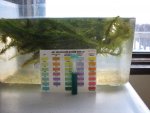Molch
Well-known member
- Joined
- Sep 28, 2010
- Messages
- 1,385
- Reaction score
- 36
- Points
- 48
- Country
- United States
So I recently got an order of Elodea densa. The plants looked a bit ragged, so I sorted out the nicer ones and put the rest in a plastic tank by the window to deal with later. Then I got busy and forgot about them for about a week.
When I looked at them this weekend, I noticed a slime film had formed on the surface and I decided to try my new ammonia test kit on the tank. The result was off the scale - at least 6 or 8 ppm!!
So...where would all that ammonia come from in a tank that contains only plants? I assume there are heterotroph bacteria breaking down the shed leaves and producing ammonia?
But...if a handful of Elodea can produce that much ammonia in a week, what does that say about putting plants like this in a tank that has not yet cycled?
I'm not to keen now too put these Elodea in my newts' tanks....
any thoughts?
When I looked at them this weekend, I noticed a slime film had formed on the surface and I decided to try my new ammonia test kit on the tank. The result was off the scale - at least 6 or 8 ppm!!
So...where would all that ammonia come from in a tank that contains only plants? I assume there are heterotroph bacteria breaking down the shed leaves and producing ammonia?
But...if a handful of Elodea can produce that much ammonia in a week, what does that say about putting plants like this in a tank that has not yet cycled?
I'm not to keen now too put these Elodea in my newts' tanks....
any thoughts?
Attachments
Last edited:




